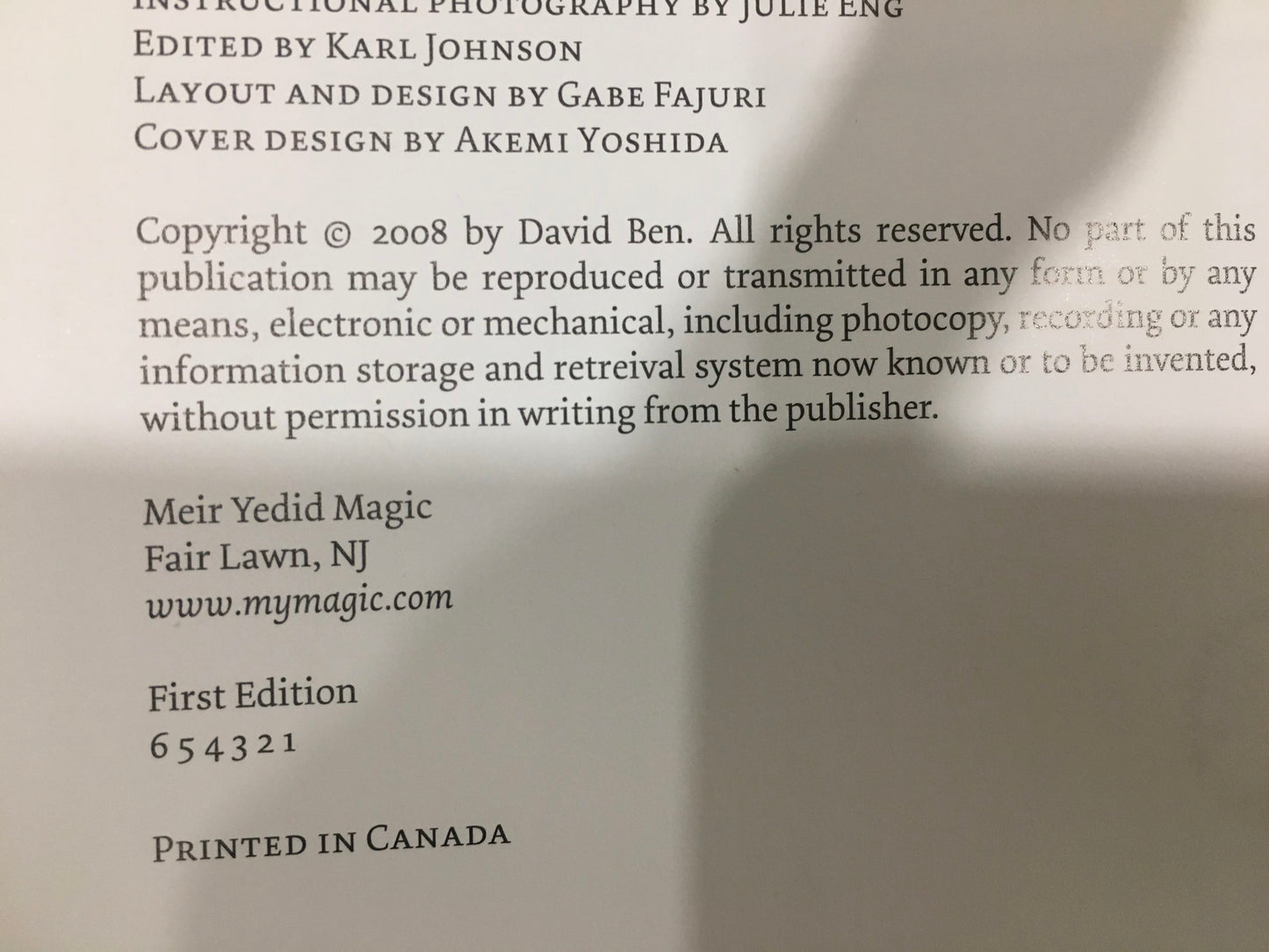Todsky’s Magic Shop
Zarrow: A Lifetime of Magic
Zarrow: A Lifetime of Magic
Couldn't load pickup availability
2008. 1st Ed. In very good condition. (See photos).
Part five of Zarrow begins with an introduction by Persi Diaconis, capturing in sepia prose a time, 50 years ago, when he was one of the "kids" at the regular Saturday afternoon gatherings where magicians, departing from Tannen's after the 4 p.m. bell, would convene at a local eatery to trade tricks and talk into the evening. High on Mount Olympus a couple of tables away sat "the big guys," as Diaconis calls them men with names like Schwarzman, Krenzel, Lorayne, Garcia, Balducci, and a frequent drop-in named Vernon. Herb Zarrow was a regular also and he was "one of the big guys."
Turn the page following this introduction and the reader is greeted by a subtitle that, much like its namesake, appears humble and unassuming, but as you sight it, you are seized by the simple force of its power: "The Zarrow Shuffle."
There follows the definitive instruction and history of the Zarrow Shuffle one of the most revolutionary and influential card sleights of the 20"' century, and the best known case if not the only one of a technique that has migrated from the conjuror's arsenal to that of the card cheat. Despite the fact that the false shuffle that bears Herb Zarrow's name as both a noun and even as a verb was created between 1949 to 1952, and first saw print in 1957, it has taken until now for many truths to be fully established and recorded. Incredibly enough, one of those most important truths is an accurate and complete description of the technique; another is the true history of its evolution and development. The truth will out, it is said, and in the 62 ensuing pages, along with several pages of footnotes, it has been thoroughly and compellingly told by David Ben.
While even the basic Zarrow Shuffle has often been mangled and misunderstood, including by some who should know better, here you will learn step-by-step, thoroughly illustrated instruction as to the correct execution of the basic shuffle, including details and finesse that have never been publicly described, as well as numerous variations, some also never before published, including multiple shuffle sequences; cutting procedures to set up for the shuffle; the "double cover" technique; cull stacking procedures; an elegant red-black application (about which I wrote in my recent memorial piece to Herb Zarrow in Genii); along with eight superb tricks, including Triumph variations, poker deals, a two-selection trick with a red-black kicker not one of them lacking in rich potential for commercial application.
Genii readers' appetites were previously whetted some months ago when they received an advanced peek at the basic instruction, along with the history of Herb Zarrow's personal odyssey with the shuffle, in these pages. But the extensive variations and routines were not included. Mr. Ben also provides an in-depth exploration of more than 400 years of history of false shuffles, which led, eventually, to the apotheosis that Herb Zarrow would create. Mr. Ben's historical research is, if I may be forgiven the cliche, impeccable including a thorough timeline, and m its entirety helps render this volume as one of the most important documents in the literature of 20th century card magic.
And that's just the last part of the book.
As for the preceding 400 pages, the book is subtitled "A Lifetime of Magic," and that's what it is: the collected life's work of the late Herb Zarrow. Although that graceful and beloved gentleman did not live to see the final version roll off the presses, he did very carefully as was his wont and his style supervise every aspect of the book from start to finish, and managed to approve all the final contents and descriptions before his recent passing, right down to the design choices. And despite the long established fame of his name in magic circles, the majority of readers will likely be astounded by the breadth and depth of the work contained in these pages.
Zarrow, not unlike his mentor, Dai Vernon, was interested and engaged in all manner of sleight-of-hand close-up magic, and those eclectic, expert, and deeply thoughtful tastes are reflected throughout this weighty and well-produced volume. And so, among the more than 150 items, there are tricks with coins, and an excellent description of Zarrow's handling of the Berg dissolving knot, and Zarrow's work on the Linking Rubber Bands which, despite the ubiquity of what many know as the "Crazy Man's Handcuffs," would be more accurately dubbed, "Herb Zarrow's Penetrating Bands," his improved handling of Arthur Setterington's "Getaway," circa 1970. And there are other interesting credit discoveries for students of the record, like Herb's creation of the Bottom Palm from The Card Magic of LePaul.
But above all, of course, there is card magic sleights, tricks, routines, finesses, improvements, inventions in short, riches galore. If you have any reasonable interest in card magic you will not only enjoy this book, you will find things to use and to love and no matter your skill level. What may in fact be startling to some is how far both ends of the scale's extremes are represented here. On the one hand, Zarrow had an interest in mathematical and sleight free tricks, and in the opening chapter, for example, there are a number of mystifying routines that are accomplished with little more than prearrangements. On the other hand, there are sleight-of-hand maneuvers in these pages that are, quite frankly, positively daunting and it makes one realize the kind of monster chops Zarrow possessed, back when the deck was going around the table, passed to and from the hands of Cardini, Horowitz, and Vernon, with Zarrow taking his turn in the midst of such titans. Chapter 17 for example, contains Zarrow's superb Spring Riffle Top Palm a move he first published around the same time as the shuffle along with some first class card table artifice, including a terrific real-world tabled "Cut Palm Replacement," a number of false cuts and table "hops" (Shifts), and a subtle and clever "One-Hand False Table Cut" that is bound to find immediate use in somebody's repertoire. But if this chapter is challenging, I'll also point out that Zarrow has a take on, of all things, the Cross Cut Force, that with the addition of a bit of sleight of hand, sharpens up this old chestnut sufficiently to slice through fast company.
The book positively bulges with utility tools and ideas. Zarrow's Block Addition technique has become a standard device since the 1960s, and among the applications recounted here is his version of Larry Jennings' "Always Cuts the Cards," a commercial miracle that borders on self-working; a trick called "Two Mental Cards" earns similar description. The Zarrow Fan Hold-Back is a diabolical utility technique that has wide application. His Center Steal Palm, inspired by the Professor Lowey Palm, delivers a card from the center of the pack into left-hand palm in elegant fashion.
Zarrow also has refinements and original takes on classics like Leipzig's "Slap Aces" that will keep you busy for quite some time if you like to practice; Vernon's "Out of Sight, Out of Mind;" and a variety of Ace routines including, at long last, the real work on his charming assembly themed around baseball, another Zarrow passion. There is an entire chapter of two-card transpositions providing seven distinct approaches including a marvelous handling that was taught to Zarrow by no less than Francis Carlyle, and was a pet trick of Zarrow's that he managed to keep quiet for about a half a century. Herb Zarrow knew how to keep a secret.
On the more demanding side of the ledger, Zarrow's approach to the full-deck "All Backs" is a tour de force and, I was surprised to learn, introduced the use of a selection to the Vernon routine years before Derek Dingle's "All Backs With Selection." Zarrow also offers an Ambitious Card routine, "Doubly Ambitious," that uses two selections instead of one and while I might have dismissed that notion in theory as mere magician's magic, having now read it, I venture to say that if someone really mastered this trick no mean feat they'd have a signature show stopper in their professional repertoire.
There are moments when life's cruel losses contain the sweet reminder of one's own good fortune. I am lucky enough to have known Herb Zarrow, and to feel the pain of his absence; he was the "Mystery Guest Lecturer" at my inaugural Card Clinic in New York City in 2002, and it was several years before that when he personally corrected the flaws in my execution of his legendary shuffle. Similarly, I find it wondrous to consider that so many of you reading this might have had the chance to meet this man, to see his work, to touch his brilliance and magic. And even if you missed out on those particular gifts, isn't it remarkable that Herb Zarrow lived long enough to meet the right man he finally asked to write his life's work? And isn't it marvelous that David Ben agreed to accept that daunting assignment, and that Zarrow had the chance to closely oversee the project in its entirety? And isn't it astounding, in a universe of random chance, that had there been just one glitch in the matrix maybe one of those things, or all of those things, might not have unfolded just that way, and then I would not be holding this astounding book in my hands? All told, it's just about as amazing as the Zarrow Shuffle not quite, but almost and isn't it just about as astonishing to consider that now you can go get a copy of your own?







Zarrow: A Lifetime of Magic • David Ben • 8 x 11" hardbound with dustjacket • 478 pages • approximately 1400 photographs